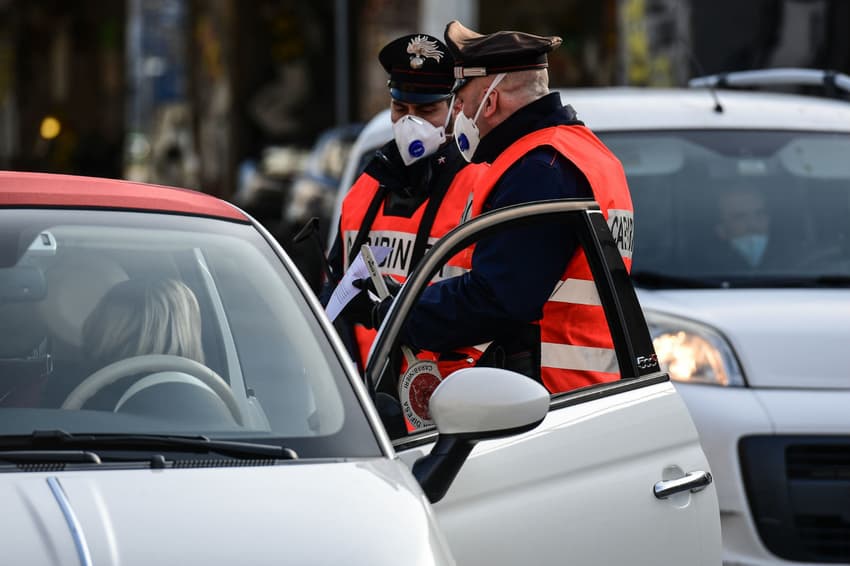Coronavirus: Switzerland closes five more border crossings between Ticino and Italy

As of midnight on Wednesday March 18the, the Swiss federal government closed more border crossings with Italy in a bid to stop the spread of coronavirus.
These additional restrictions come as Switzerland’s confirmed Covid-19 cases now number 3,028, although the real figure is likely much higher given not every suspected case is being tested.
#CoronaInfoCH #Coronavirus
Actuellement, 3028 cas ont été testés positifs, dont 2772 cas confirmés et 256 cas encore en cours d’analyse après un premier résultat positif. https://t.co/Zac4HBaDFV pic.twitter.com/R7dvYGhpNE
— BAG – OFSP – UFSP (@BAG_OFSP_UFSP) March 18, 2020
The newly closed border crossings between Ticino and Italy are Arogno, Brusino, Pizzamiglio, Camedo and Fornasette.
On March 11th, the Swiss government already closed nine entry points between Ticino and Italy to limit the traffic from the country that is at the forefront of the Covid-19 outbreak. It is the worst-hit country in Europe and outside China.
READ MORE: EXPLAINED: Why did Switzerland partially close its border with Italy
However, the Federal Council is not closing the border completely. Open points include Chiasso strada (Ponte Chiasso), Novazzano Brusata (Bizzarone), Chiasso strada, Stabio Gaggiolo, and Dirinella (Zenna).
These crossings remain open as Ticino’s economy relies heavily on 67,800 Italian employees who make up more than a quarter of the total workforce in the canton.
About 4,000 of these frontaliers work in the healthcare sector, so closing the border would deprive Ticino's hospitals of the basic personnel at a time when the number of coronavirus cases is on the rise.
A similar situation exists in Geneva, which shares a border with France.
In total, 85,000 French citizens work in Geneva, making up 60 percent of the personnel at the canton’s university hospital (HUG).
As so many cross-border workers are employed in the medical sector, Geneva authorities implemented this week a ‘filtering' system allowing health care workers to have priority access.
These workers now have special stickers identifying them as medical employees. Similar priority access is also given to other essential personnel, such as police.
READ MORE: Geneva's cross-border traffic streamlined based on priority
Switzerland also closed many of its border crossings with neighbours Germany and Austria.
In all, 130 crossings are shuttered or partially closed.
Here is a full list of closed borders.
“These measures aim to protect the Swiss population and maintain the capacities of the Swiss health system,” the Federal Council said.
It added that Liechtenstein is not affected by this measure because it is part of the Swiss customs territory.
Entry is now only possible for Swiss citizens, people with a residence permit in Switzerland, cross-border workers with a G-permit, as well as those who must travel in Switzerland for professional reasons. Transit and transport of commercial (but not private) goods remain authorised.
Comments
See Also
These additional restrictions come as Switzerland’s confirmed Covid-19 cases now number 3,028, although the real figure is likely much higher given not every suspected case is being tested.
#CoronaInfoCH #Coronavirus
— BAG – OFSP – UFSP (@BAG_OFSP_UFSP) March 18, 2020
Actuellement, 3028 cas ont été testés positifs, dont 2772 cas confirmés et 256 cas encore en cours d’analyse après un premier résultat positif. https://t.co/Zac4HBaDFV pic.twitter.com/R7dvYGhpNE
The newly closed border crossings between Ticino and Italy are Arogno, Brusino, Pizzamiglio, Camedo and Fornasette.
On March 11th, the Swiss government already closed nine entry points between Ticino and Italy to limit the traffic from the country that is at the forefront of the Covid-19 outbreak. It is the worst-hit country in Europe and outside China.
READ MORE: EXPLAINED: Why did Switzerland partially close its border with Italy
However, the Federal Council is not closing the border completely. Open points include Chiasso strada (Ponte Chiasso), Novazzano Brusata (Bizzarone), Chiasso strada, Stabio Gaggiolo, and Dirinella (Zenna).
These crossings remain open as Ticino’s economy relies heavily on 67,800 Italian employees who make up more than a quarter of the total workforce in the canton.
About 4,000 of these frontaliers work in the healthcare sector, so closing the border would deprive Ticino's hospitals of the basic personnel at a time when the number of coronavirus cases is on the rise.
A similar situation exists in Geneva, which shares a border with France.
In total, 85,000 French citizens work in Geneva, making up 60 percent of the personnel at the canton’s university hospital (HUG).
As so many cross-border workers are employed in the medical sector, Geneva authorities implemented this week a ‘filtering' system allowing health care workers to have priority access.
These workers now have special stickers identifying them as medical employees. Similar priority access is also given to other essential personnel, such as police.
READ MORE: Geneva's cross-border traffic streamlined based on priority
Switzerland also closed many of its border crossings with neighbours Germany and Austria.
In all, 130 crossings are shuttered or partially closed.
Here is a full list of closed borders.
“These measures aim to protect the Swiss population and maintain the capacities of the Swiss health system,” the Federal Council said.
It added that Liechtenstein is not affected by this measure because it is part of the Swiss customs territory.
Entry is now only possible for Swiss citizens, people with a residence permit in Switzerland, cross-border workers with a G-permit, as well as those who must travel in Switzerland for professional reasons. Transit and transport of commercial (but not private) goods remain authorised.
Join the conversation in our comments section below. Share your own views and experience and if you have a question or suggestion for our journalists then email us at [email protected].
Please keep comments civil, constructive and on topic – and make sure to read our terms of use before getting involved.
Please log in here to leave a comment.